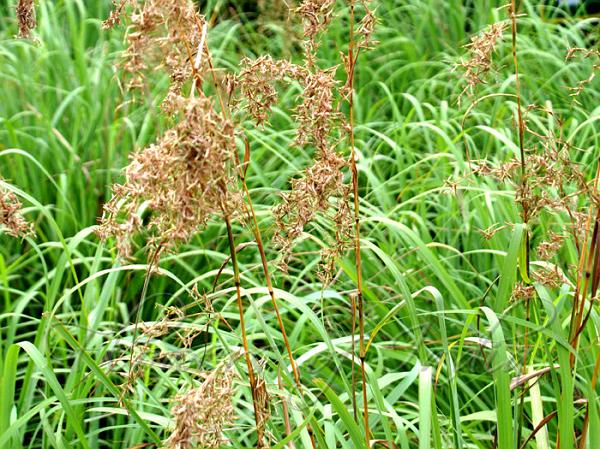|
| Jwarankush Grass |
|

|

| File size | 235411 |
| Original date | 5/8/11 5:22 PM |
| Resolution | 700 x 525 |
| Flash | Flash did not fire, auto |
| Focal length | 50.0mm |
| Exposure time | 1/80s |
| Aperture | 5.6 |
| Focus Distance | |
| Metering Mode | Multi-segment |
| Camera make | SONY |
| Camera model | DSLR-A100 |
| Sensor type |
|
|
|
|
Photo: |
Botanical name: Cymbopogon iwarancusa Family: Poaceae (Grass family)
Synonyms: Andropogon iwarancusa, Sorghum iwarancusa, Cymbopogon jwarancusa
Synonyms: Andropogon iwarancusa, Sorghum iwarancusa, Cymbopogon jwarancusa
Jwarankush Grass is a perennial grass with stems erect
or geniculately rising up, up to 1.5 m tall. The name probably comes
from jwar, meaning fever, and kush meaning grass.
Leaf-blades are up to 30 cm long and 5 mm wide, whitish, narrowed at
the base, narrowed to a thread-like tip; basal sheaths hairless, flat
or coiled; ligule 0.5-4 mm long. False panicle 15-40 cm long, erect;
spatheoles lanceshaped to narrowly elliptic, becoming reddish, 1.5-2.5
cm long. Racemes are 1.3-2.2 cm long, lowest flower-stalk not swollen;
internodes and flower-stalks densely fringed with hairs along the
margins and on the hack. Stalkless spikelet lanceshaped, 4.5-5.5 mm
long; lower glume shallowly concave on the back; upper lemma deeply
bifid, with an awn 7-10 mm long. Jwarankush Grass is found from Turkey
to India to S. Central China.
Medicinal uses: The leaves if Jwarankuch are
antirheumatic, antitussive, aromatic, blood purifier, febrifuge,
stimulant, sudorific and tonic. They are used in the treatment of
fevers, coughs, rheumatism, gout, dyspepsia, cholera etc. The roots are
commonly used in India for the treatment of a range of feverish
conditions. They are boiled in water until the amount of water is
halved and this liquid is then kept in the mouth for 15 - 20 minutes to
treat pyorrhea.
The leaves if Jwarankuch are
antirheumatic, antitussive, aromatic, blood purifier, febrifuge,
stimulant, sudorific and tonic. They are used in the treatment of
fevers, coughs, rheumatism, gout, dyspepsia, cholera etc. The roots are
commonly used in India for the treatment of a range of feverish
conditions. They are boiled in water until the amount of water is
halved and this liquid is then kept in the mouth for 15 - 20 minutes to
treat pyorrhea.
Medicinal uses:
 The leaves if Jwarankuch are
antirheumatic, antitussive, aromatic, blood purifier, febrifuge,
stimulant, sudorific and tonic. They are used in the treatment of
fevers, coughs, rheumatism, gout, dyspepsia, cholera etc. The roots are
commonly used in India for the treatment of a range of feverish
conditions. They are boiled in water until the amount of water is
halved and this liquid is then kept in the mouth for 15 - 20 minutes to
treat pyorrhea.
The leaves if Jwarankuch are
antirheumatic, antitussive, aromatic, blood purifier, febrifuge,
stimulant, sudorific and tonic. They are used in the treatment of
fevers, coughs, rheumatism, gout, dyspepsia, cholera etc. The roots are
commonly used in India for the treatment of a range of feverish
conditions. They are boiled in water until the amount of water is
halved and this liquid is then kept in the mouth for 15 - 20 minutes to
treat pyorrhea. | Identification credit: Gurcharan Singh | Photographed in Hamdard Herbal Garden, Delhi. |
• Is this flower misidentified? If yes,